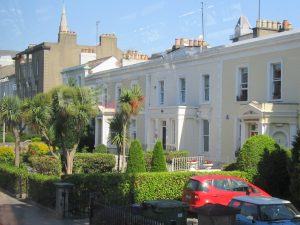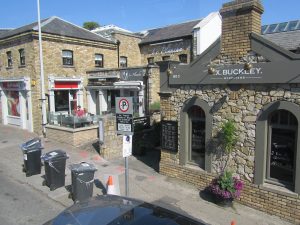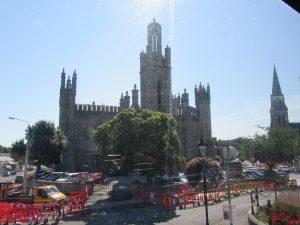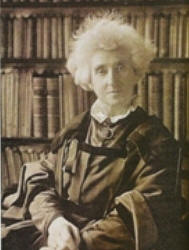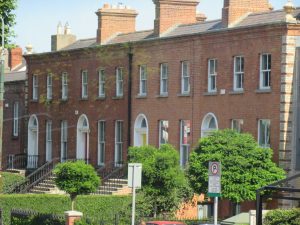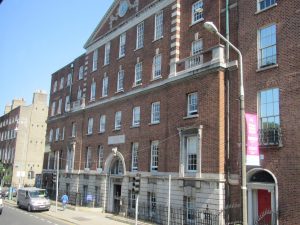That’s not true at all, to be honest. It was 10:30 and we don’t have a dog, although Cassia asks for one every single day. It’s a line from an Emily Dickinson poem that I’ve always liked because it pretty much tells a whole story in five words, a talent that I don’t have. I need lots of words.
Last week when the younger kids were going around the country on bus trips with their summer programme I found myself with the most free time I’ve had since coming here. Cassia finishes school at 1:30 which doesn’t allow a huge window for going into town but the bus trip days didn’t finish until 4:00, giving me a giddy and previously un-dreamt-of amount of freedom. I did try to convince the teenagers to come and have adventures with me but somehow I didn’t make the idea of going on the bus into Dublin to wander around and look at things sound cool enough. The great thing about teenagers, though, is that you can leave a list of jobs on the table and go without them. So I did.
I didn’t do anything particularly exciting. I just went, that was all, but I thought I’d show you anyway. Pretty much it’s a display of blurry pictures of power poles, because I was taking them from a moving bus, but they’re Irish power poles so they have novelty value. So come with me on a trip into a thousand-year-old city that changes every day.
You don’t get anything of the 700-metre walk from home to the bus stop because I was eating my toast. I had started early, after all.
I waited at the bus stop at the corner of Sallyglen Road and Rochestown Ave in the lovely summer sun
and, once the bus came, went past Aldi. The Aldi, a lovely cheap supermarket with truly excellent apple turnovers, was built not long ago and all this free land beside it was part of the construction site for a while. They had their Portaloos along the edge right by the bus stop and if you were sitting on the top deck you were treated, while you waited for people to disembark, to the back views of all the builders popping in for a whizz without bothering to shut the door. Five feet away. When the Aldi was finished this was bare dirt and we were all on the edge of our seats wondering what would go there. A nice shoe shop maybe, or – ooh, I know – a Marks and Spencers Food Hall! Yes! It’s a huge amount of ground to be left undeveloped, you could fit high-density housing for many many people, and possibly that’s in its future but for now here’s what they’ve done:
You maybe can’t tell from the photo but the whole thing – and it’s big – is planted in wildflowers. All the red bits? Flowers. It’s like a great big urban poppy field. Nicely done, somebody.
We passed some houses and came into sight of the sea
and saw a girl with lovely red hair, because there’s always someone around with red hair. It comes from the Normans, I believe. Noah has a friend named Patrick with blazing hair, which shows that Noah’s got a good handle on what Ireland is all about. Presumably in ten years’ time red-haired Patrick will have discovered Guinness for the trifecta.
Now we’re going through the seaside village of Dun Laoghaire. You also see the Anglicised version, Dunleary, and thanks to a visit to the local Maritime Museum I now know why. Dunleary was the common spelling in the olden days – days less tolerant of Irish – until it was re-named Kingstown in 1821 in honour of the English king. By 1920, however, the English monarchy had fallen way out of favour and the town was again given its traditional name, Dun Laoghaire (meaning ‘Fort of Laoghaire’, referring to the ancient Irish high king Laoghaire Mac Néill, who used the area as a base for raids on Britain and Gaul in the 5th century. Traces of his fortifications can still be found) with its Irish spelling. So now you know too.
Something about Ireland is, there are flowers everywhere. Gardens, streets, windows, parks, people just love their flowers. We arrived in winter and the place – even the central city where we were – was awash with daffodils.
Very tiny peek of sea there at the bottom of Marine Road.
Then we head into Monkstown. I don’t know why it’s called that.
It has lovely, lovely shops and restaurants and this spectacular church with more history than I could tell you in a dozen posts. It has fantastic stained glass windows in the Persian Carpet style (it’s really called that, I didn’t just make it up), i.e. intricate geometric patterns, used in Protestant churches in a time when the use of anything hinting at Papism – religious icons, images of people etc – was a hellfire-level offence. Of course, as with almost all of the most impressive churches and cathedrals, it started life as a Catholic place of worship and was confiscated along the way.
The kids and I did a tour of the church during last year’s Summer of Heritage programme. Nobody wanted to but it was free and making them do free stuff is one of my personal superpowers. It was worth it though because there was a treasure hunt inside with very decent-sized bags of sweets as the prize, so they came away happy. Also there were all sorts of carvings of animals, Green Men and other cool stuff so although they weren’t quite falling all over each other afterwards to tell me how thankful they were for being taken there, I know they were thinking it.
Up along the altar there was a long backdrop of gorgeous mosaic of great age. Recently they managed to raise the money to have it restored, an extremely expensive and time-consuming job because there are very few people with the necessary expertise and they had to import someone. Why did it need restoration? Well, back in the sixties the devout ladies of the church-decorating committee decided that this ancient vine-patterned mosaic was taking away from the beauty of their flower-arrangements so they painted over it. In beige.
Although, as I say, the stories associated with this church and area would fill a library so I won’t even try, I will give this lady a mention as part of my kick-ass Irish women theme:
‘First lady of Spectroscopy. Dame Margaret Lindsay Huggins (nee Murray)(1848-1915) spent her childhood at 23 Longford Terrace, where she was a contemporary and neighbour of Sir Howard Grubb, where they they shared an interest in optical instruments. Margaret even constructed a small telescope herself to map stars by night and sunspots by day. Indeed, it is said that Grubb had a hand in bringing together Margaret and her future husband Sir William Huggins already a distinguished astronomer. They were married at Monkstown Church of Ireland on 8th Sept 1875. He was 51, she was 27.
Although she often portrayed herself as her husband’s able assistant, it is now accepted that she was the main impetus behind a programme of photographic spectroscopy. Spectroscopy is the analysis of electromagnetic radiation (including visible light) to determine the properties of an astronomical object. Much of her work relates to the study of the Orion Nebula, which showed that the nebula consisted of gases rather than stars as previously believed.’
Do you see that? She lived over a hundred years ago, she didn’t have a penis, and she more or less invented spectroscopy. What are the chances? Kick-ass, that’s what I’m telling you.
And, just so you’re fully up with the programme, since it mentioned the unfortunately-named Sir Grubb, also a Monkstown local:
‘Sir Howard Grubb and the Periscope. Although the principles of the periscope were well known beforehand, Sir Howard Grubb(right) (1844-1931) was the first to design a practical periscope for use in a wartime submarine during WW1. He had worked with his father’s firm, the Grubb Telescope Company, which helped to build the Leviathan, mentioned at no. 3 above. Grubb telescopes were also supplied to the Dunsink and Armagh observatories. There is a plaque on his house at Longford Terrace, Monkstown. By the date of the 1911 census he was living in no 14 Orwell Road, Rathgar.’
And just because I think his facial hair is so impressive let’s do one more:
‘Radio Waves and the first sports commentary on radio George F Fitzgerald (1851-1901), TCD (Trinity College Dublin) physics professor was the first to suggest that an oscillating current in suitable circumstances would produce radio waves. His work, together with that of Maxwell and Hertz, laid the groundwork for Marconi’s wireless telegraphy. In 1898, in a collaboration between Marconi and Fitzgerald, the first sports commentary on radio took place at the Dun Laoghaire Regatta. His writings on the speed of light pre-date Einstein, and he attempted to fly a glider in TCD sports ground. He spent much of his youth in Monkstown, and his father was rector at Kill o the Grange. The Fitzgerald Crater on the Moon is named after him. It is 110km in diameter, with some sub-craters. Unfortunately, it is on the far side of the moon, never seen from earth, and only visible from satellites.’
Moving right along. Behind the red-hot mess is one of my top-five Happy Places. I ♥ M&S, and that’s all I’m going to say about that.
We’re now in Blackrock where Amy goes to school. She walks past this octagonal church which also had a free tour with a treasure hunt and chocolate buttons. They know how to promote heritage in these parts, I’m telling you.
Then we head through Booterstown and you can see how close we’ve been to the sea all this time. The tide’s out right now and it looks as though you could walk right over to Howth, that hilly bit in the background which is the northern headland of Dublin Bay. We live on the southern headland.
This one’s looking towards the city and the two towers at the Poolbeg Generating Station, visible from almost anywhere in Dublin.
A few more houses:
A park:
More churches:
The commuter train level crossing:
And St Vincent’s Hospital, controversial site of the new National Maternity Hospital:
Now we’re coming into the posh area of Ballsbridge with its Georgian architecture. In Georgian times the width of your front doorway, the fanciness of the decorative fan arrangement above it, and the number of steps up to it were all signs of wealth and status.
Nowadays just being able to live in Ballsbridge at all is a sign of the same.
And here I got distracted by my own hand. A few days earlier we’d been to Amazon’s summer family day – the Mad Hacker’s Tea Party – and a lovely girl henna’d me. It’s gone now but I did love it while it lasted.
Finally we’re arriving in the central city. Josh sometimes eats his lunch by the canal a bit further up from here and occasionally gets to see the locks being opened for boats to pass through.
Here we have the National Maternity Hospital, the other side of the St Vincent’s story and the birthplace of my first baby. I will say that having parking available would add a little something to the experience.
We have arrived at Merrion Square with its Oscar Wilde statue so beloved of tourists, and also, on top of a plinth, a small green statue of his pregnant mother. Oscar grew up just across the street at No. 1 Merrion Square.

Because it’s pretty cool I’m going to let someone with way more knowledge than me – a writer for the trinitynews.ie website – describe it to you:
The surprising geology of Dublin’s Oscar Wilde statue
Gavin Kenny
Science Editor
Incorporating five beautifully colourful and exotic rock types from three different continents, the sculpture of Oscar Wilde in Dublin’s Merrion Square is truly a geological wonder.
The city of Dublin sports innumerable statues and sculptures of its famous former residents but most, quite literally, pale in comparison to the striking, multi-coloured sculpture of its beloved son Oscar Wilde. Since its unveiling in 1997, the work of art, commissioned by Guinness Ireland Group and executed by Danny Osborne, has earned its place as a regular stop on Dublin’s tourist trail. But not many people, geologists included, appreciate the true beauty of the work.
Walking up to the statue for the first time I was immediately struck by the shimmer of Wilde’s trousers and on closer inspection I found them to contain huge crystals of a mineral called feldspar up to a few centimetres across. My face right up against the statue I was then attracted to Wilde’s lurid smoking jacket. The materials were clearly natural yet they seemed to flow so fluidly. I was reminded of the Ancient Greek sculpture of Nike adjusting her Sandal – a marble relief from the Temple of Athena Nike at the Acropolis, Athens (410-405 BC), in which the sculptor makes solid marble appear to flow like fabric and hang almost weightlessly.
My interest ignited, a quick Google search later I came across a fascinating review of the sculpture and its geologically aspects by Prof Chris Stillman who spent forty years in College’s Geology Department. I soon learned of the extraordinary rock types used by Osborne to produce Wilde on his perch. The mesmerizing trousers worn by Wilde are composed larvikite – a coarse-grained igneous rock often known as Blue Pearl Granite due to its striking blue iridescence. The larvikite perfectly mimics a coarse tweed fabric and the effort of shipping it from the Oslo Fjord in Norway, is easily justified.
“The vivid colours, straight from the natural world, capture Wilde’s flamboyant character. One can easily imagine Wilde, adorned by his unapologetic smoking jacket, shimmering trousers, and cheeky smile, flicking his head towards a US Customs Control officer to offer: “I have nothing to declare but my genius.”
Wilde’s brash smoking jacket is a combination of green nephrite jade from the extreme north of British Columbia, close to the Yukon, Canada, and pink thulite from Western Norway that composes the collar and cuffs. The Canadian jade is from a zone of contact metamorphism where relatively rare ultramafic magma intruded the local country rock, while the Norwegian thulite was mined from veins in metamorphosed shales and sandstones.
Wilde’s black shoes and socks may take a back seat to their chromatic siblings but they are no less exotic. The black Indian granite, known as charnockite, is from southern India and contains a distinctive pyroxene mineral known as hypersthene.
Ireland too contributes a piece of its geology to the jigsaw. The huge rock on which the sculptor has perched Wilde is a 35 tonne boulder of quartz transported from the Wicklow Mountains where it had weathered out of a vein in the Leinster Granite. Osborne, who found the boulder himself, must be congratulated on placing Wilde so naturally. In the words of Wilde himself, “being natural is simply a pose,” but this reclining pose, as the subject faces his childhood home on Merrion Square, is a true demonstration of a master artist at work.
To complete the piece, Osborne employed the bare minimum of man-made materials. Wilde’s shoes are finished with delicate bronze laces while the head (modelled on that on Wilde’s living grandson Merlin Holland) and hands were original composed of porcelain. However, the head fell into disrepair and was replaced by a more durable jade one in 2009.
In addition to the beautiful use of wonderful natural materials, I love the cleverness of the sculpture. The vivid colours, straight from the natural world, capture Wilde’s flamboyant character so perfectly. One can easily imagine Wilde, adorned by his unapologetic smoking jacket, shimmering trousers, and cheeky smile, flicking his head towards a US Customs Control officer to offer: “I have nothing to declare but my genius.” He struts on, head held high, his heavily polished, charnockite-granite-black shoes clicking loudly as he exits.’
It’s a shame that Oscar Wilde was treated so abysmally in life, and nothing makes up for that, but it’s pretty cool that so much thought and effort went into the statue.
And now I am going to take pity and let you go. We’ll continue our tour another day.








